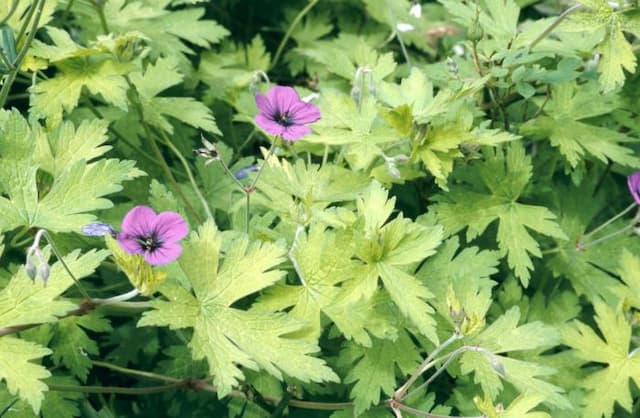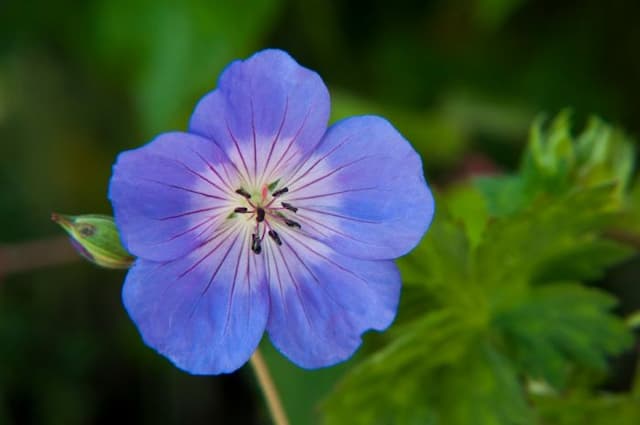Apple geranium Pelargonium odoratissimum (Sc)

ABOUT
Pelargonium odoratissimum, commonly known as the apple-scented geranium, is a visually appealing plant distinguished by its plush, velvety foliage. The leaves have a distinctive heart-shaped appearance, often with rounded edges that give them a soft, gentle look. The apple-scented geranium boasts a bright green color that gives it a vibrant and lively appearance. These leaves are also noted for their fragrance, which, as the name suggests, is reminiscent of fresh apples. The plant often produces small, delicate flowers that can range in color from white to pale pink, adding a splash of subtle color to the green backdrop of the foliage. These blooms may have thin, dark markings on the petals, offering a pleasing contrast and adding to the plant’s ornamental charm. The stems are typically succulent and may appear slightly woody as the plant matures, offering a robust structure to the softer textures of the leaves and flowers.
About this plant
 Names
NamesFamily
Geraniaceae
Synonyms
Apple Geranium, Sweet-Scented Geranium, Nutmeg Geranium, Old Fashioned Rose Geranium
Common names
Geranium odoratissimum, Pelargonium album, Pelargonium blandum, Pelargonium moniliforme, Pelargonium odoratissimum var. blandum
 Toxicity
ToxicityTo humans
The apple-scented geranium, commonly known as apple geranium, is not considered toxic to humans. These plants are often grown for their fragrant leaves and are not known to cause poisoning if ingested. However, it is always advisable to avoid eating ornamental plants as a general safety rule.
To pets
Apple geranium is also not known to be toxic to pets. It is generally considered safe around pets, such as cats and dogs, and there are no significant symptoms of poisoning reported from ingestion. Nonetheless, as with any non-food plants, it is always a good practice to prevent pets from ingesting plant material to avoid any potential gastrointestinal upset or unexpected reactions.
 Characteristics
CharacteristicsLife cycle
Perennials
Foliage type
Evergreen
Color of leaves
Green
Flower color
White
Height
1-2 feet (30-60 cm)
Spread
1-2 feet (30-60 cm)
Plant type
Herb
Hardiness zones
10
Native area
South Africa
Benefits
 General Benefits
General Benefits- Aesthetic appeal: Pelargonium odoratissimum, commonly known as sweet-scented geranium, has attractive, rounded, and soft green leaves often used in gardens and landscape design for its visual charm.
- Fragrance: The leaves of the sweet-scented geranium release a pleasant, apple-like fragrance when touched, which can enhance the sensory experience in a garden setting.
- Culinary use: The aromatic leaves of the sweet-scented geranium can be used in flavoring desserts, jellies, teas, and other culinary dishes.
- Easy maintenance: Sweet-scented geranium is known for being low-maintenance, making it an ideal plant for both novice and experienced gardeners.
- Drought tolerance: This plant is drought-tolerant once established, which makes it suitable for water-wise gardens and reduces the need for frequent watering.
- Pest repellent: The fragrant leaves of the sweet-scented geranium can help repel some pests naturally, providing a degree of protection for nearby plants.
- Companion planting: Sweet-scented geranium is often used in companion planting to benefit other plants by detering pests and attracting beneficial insects.
 Medical Properties
Medical Properties- Antimicrobial: Pelargonium odoratissimum, commonly known as apple geranium, has been used in traditional medicine for its potential antimicrobial properties against certain bacteria and fungi.
- Anti-inflammatory: The plant is sometimes used in herbal preparations for its anti-inflammatory effects, which could potentially aid in reducing inflammation-related symptoms.
- Expectorant: Apple geranium is traditionally used to help relieve symptoms of the common cold and as an expectorant to aid in clearing mucus from the respiratory tract.
- Analgesic: It may have pain-relieving properties that could be utilized to soothe minor aches and pains.
- Sedative: Some use Pelargonium odoratissimum for its sedative effects, which could help to promote relaxation and potentially aid in sleep.
- Astringent: The astringent qualities of apple geranium can be used in traditional practices to tighten tissues and reduce discharge or bleeding.
 Air-purifying Qualities
Air-purifying QualitiesThis plant is not specifically known for air purifying qualities.
 Other Uses
Other Uses- Potpourri Additive: The dried leaves of apple geranium are often added to potpourri for their sweet, apple-like fragrance that can freshen up any room.
- Culinary Flavoring: The leaves of apple geranium can be used to flavor jellies, cakes, sugars, and teas, providing a subtle apple-note to various dishes and beverages.
- Aromatherapy: Apple geranium's essential oils are sometimes used in aromatherapy for their calming and uplifting scent.
- Natural Insect Repellent: The scented leaves of apple geranium can be rubbed on the skin to ward off insects or placed near doorways and windows as a deterrent.
- Garden Companion Planting: Apple geranium can be planted alongside vegetables and other plants to help repel pests with its strong scent.
- Perfumery: The essential oil extracted from apple geranium is occasionally used as a component in perfume making, especially for creating floral and apple-like fragrances.
- Soap Making: The oil or crushed leaves of apple geranium are infused into soaps for their scent and potential skin-soothing properties.
- Dyeing Fabric: The leaves and flowers can be used to naturally dye fabrics, giving them a light green or brown tint depending on the mordant used.
- Decoration: Fresh cut stems of apple geranium are sometimes used as a decorative, fragrant addition to floral arrangements and bouquets.
- Religious Ceremonies: In some cultures, the aromatic leaves of apple geranium are used during religious and spiritual ceremonies for their purportedly cleansing and uplifting aroma.
Interesting Facts
 Feng Shui
Feng ShuiThe Apple-scented Geranium is not used in Feng Shui practice.
 Zodiac Sign Compitability
Zodiac Sign CompitabilityThe Apple-scented Geranium is not used in astrology practice.
 Plant Symbolism
Plant Symbolism- Comfort: Also known as "Sweet-scented Geranium," Pelargonium odoratissimum is often associated with comfort due to its pleasant and soothing fragrance, offering a sense of calm and reassurance.
- Healing: With its medicinal properties, the Sweet-scented Geranium is symbolic of healing and is often used in traditional remedies to treat various ailments, representing the plant's restorative qualities.
- Hospitality: The Sweet-scented Geranium is also a symbol of hospitality, as its aromatic leaves were traditionally placed in finger bowls for guests to rinse their hands, signifying a warm and welcoming environment.
- Positivity: Its refreshing scent and presence in gardens are believed to elevate mood and promote positivity, making it a token of good vibes and happiness.
 Water
WaterThe Apple-scented Geranium should be watered thoroughly, allowing the soil to dry out slightly between waterings. Typically, this means watering about once a week, but this can vary depending on the ambient temperature and humidity levels. Use enough water to moisten the soil evenly throughout the pot, using approximately 1 to 2 cups (8 to 16 ounces) per watering session for a standard pot size. During the winter months, reduce the frequency as the plant’s growth slows down, possibly extending to every other week. It's crucial not to let the plant sit in water as it can lead to root rot.
 Light
LightThe Apple-scented Geranium prefers bright, indirect light to thrive. A spot near a window that receives morning light or filtered afternoon sun is ideal. Avoid placing it in direct, harsh sunlight as this can scorch the leaves. East or west-facing windows are typically the best spots for this plant, providing the right balance of light without the intense exposure of the midday sun.
 Temperature
TemperatureThe Apple-scented Geranium does well in temperatures ranging from about 55 to 70 degrees Fahrenheit. It can survive temporary dips just below 50 degrees Fahrenheit but should not be exposed to frost. To promote healthy growth, keep the plant in an environment that avoids temperature extremes and drafts. The ideal temperature is a consistent, moderate range that emulates its native environment.
 Pruning
PruningPruning the Apple-scented Geranium is important to encourage bushy growth and to maintain an attractive shape. Prune or pinch back the tips of the plant during the spring or summer, which is the best time for vigorous growth. Remove any dead or yellowing leaves as needed throughout the year. Pruning can be done every couple of months or whenever the plant looks like it could benefit from shaping.
 Cleaning
CleaningAs needed
 Soil
SoilThe best soil mix for Apple-scented Geranium is well-draining soil with compost or peat moss and perlite. The ideal soil pH should range between 6.0 and 7.0.
 Repotting
RepottingApple-scented Geranium should be repotted annually or when it outgrows its pot to ensure continued growth and to refresh soil nutrients.
 Humidity & Misting
Humidity & MistingApple-scented Geranium prefers moderate humidity levels; however, it can tolerate dry indoor air, but should not be in overly humid conditions.
 Suitable locations
Suitable locationsIndoor
Place Apple-scented Geranium in bright indirect light with proper air circulation indoors.
Outdoor
Plant in partial sun with shelter from strong winds outside.
Hardiness zone
10-11 USDA
 Life cycle
Life cycleThe common name of Pelargonium odoratissimum is the apple geranium. The life cycle begins with seed germination, where under favorable conditions, the seeds sprout and develop into seedlings. As the seedlings grow, they enter the vegetative stage, producing stems, leaves, and roots. The plant then matures and enters the flowering stage, producing characteristic fragrant flowers that attract pollinators for sexual reproduction. After pollination and fertilization, the flowers develop into seed capsules, which eventually release seeds once matured, completing the cycle. It's a perennial plant, so after the first complete cycle, apple geranium can continue growing and repeating the flowering and seeding stages annually.
 Propogation
PropogationPropogation time
Spring-Early Summer
The Apple Geranium, scientifically known as Pelargonium odoratissimum, is conveniently propagated through stem cuttings. The best time to propagate this fragrant plant is in late winter to early spring before the onset of new growth, or during the early part of the summer. To propagate, choose a healthy, disease-free stem that is about 3 to 4 inches (approximately 7.6 to 10.2 cm) long and cut just below a node using a sharp, clean knife or scissors. Remove the leaves from the lower half of the cutting to prevent moisture loss and possible rotting when planted. The cutting should then be allowed to dry for a few hours to form a callus over the cut surface, which helps prevent disease. Once callused, the cutting can be dipped in rooting hormone and planted in a mixture of moist potting soil and perlite or sand. The pot should be placed in a warm, bright area but out of direct sunlight until roots develop, often within a few weeks, after which it can be transplanted.









